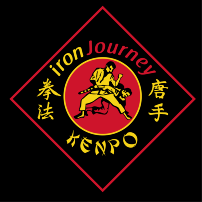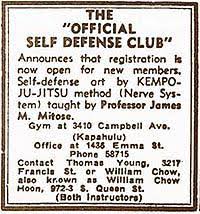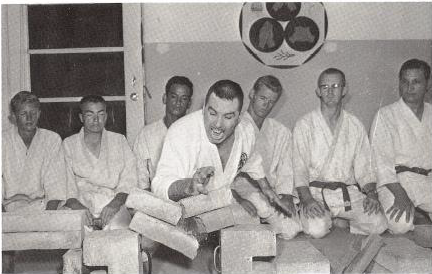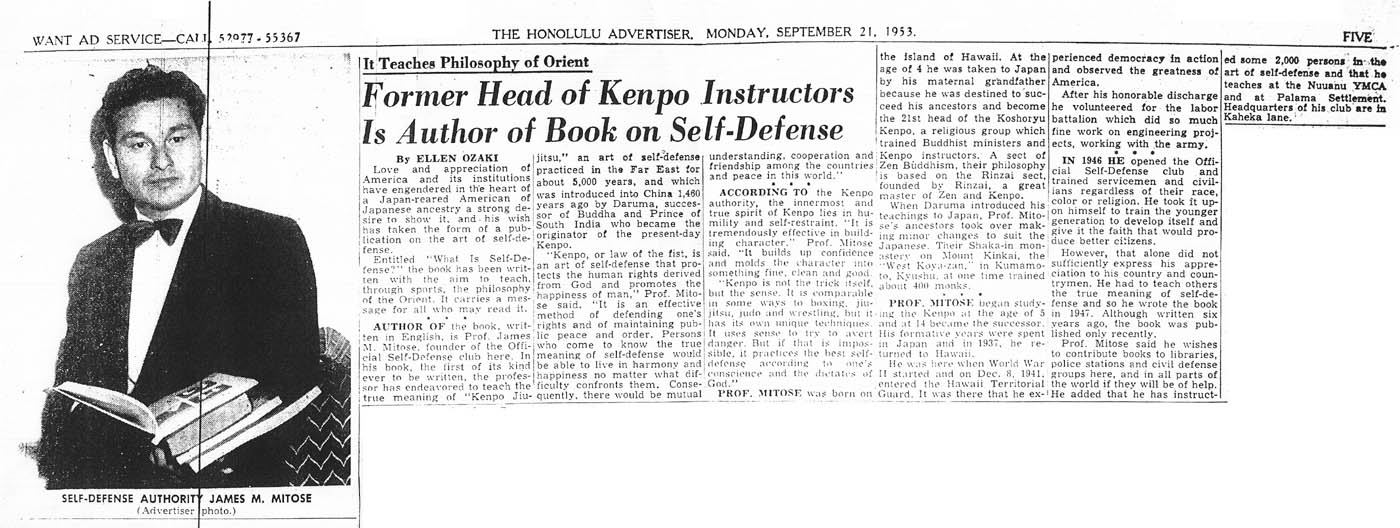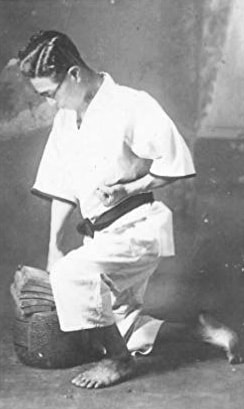Below you will find a chronological history of modern Kenpo, it is what we know about the people and places at the time Kenpo was developed.
Japanese Years 1920 - 1937
James Masayoshi Mitose in 1920 at the age of three was taken by family members to Kyushu Japan, to be raised by his family to be given formal education and upbringing.
No official training records with James Mitose and known masters can be found for him while in Japan. We don't know who he trained with or what he learned, we also don't know if he trained at all.
The only thing we truly know is what he taught in Hawaii.
Some definitions are required because today each of these words are overloaded with meaning, so we have to step back in time for a true understanding.
- Karate at this point meant "Chinese Hand" or "Tang Hand" not "Empty Hand" this change wouldn't come until 1939 in Japan. Karate is mainly striking and kicking arts that came from Okinawa with its roots in China.
- Kenpo literally means "fist law" or "fist way" at this point time it meant an Okinawan System with Chinese roots, the Chinese pronunciation of Kenpo is ch'uan fa.
- Jujitsu - is a Japanese art of locking, throwing, grappling with some striking and kicking, it's a war art of combat.
- Kenpo "拳法" Karate "唐手"
- 拳"fist" 法 "law" 唐 "tang or china" 手 "hand"
It's important to understand what was happening in Japan during the time period of 1920 - 1937. The most common arts in Japan at the time were Judo and Jujitsu. It's not until 1921 when Okinawa Kenpo Karate-Jutsu Kumite was introduced to Japan by Choki Motobu.
Choki Motobu moved to Osaka Japan in 1921 and introduced his Okinawa Kenpo Karate-Jutsu Kumite, Karate-Jutsu means an emphasis focused on effective technique, not on kata development which was unique to Choki Motobu's art.
Choki Motobu honed and developed his art in Okinawa and was a known fighter with a fierce reputation. His main training and teaching method was to practice effective techniques with a uke back and forth, it was this type of training which developed the effective art of Kenpo.
Gichin Funakoshi introduced his Okinawa Karate to the Japanese mainland in 1922 and later founded Shotokan which was the name of the first official dojo he built in 1936. Shotokan was a kata based art comprised of 27 katas.
In 1939 Gichin Funakoshi and other Masters changed the meaning of Karate from "China hand" 唐手 to "Empty hand" 空手.
Hawaii Years
Time period 1903 - 1936
Hawaii has always had a large Asian population because of its geographic location, it quickly became a center of martial arts training. It's evident that Karate was practiced in the Okinawan communities as early as 1903.
It's important to understand what was happening in Hawaii during this time period as Karate and Jujitsu are introduced into the Hawaiian Islands.
Henry Okazaki established his Danzan Ryu dojo in Honolulu in 1929, and openly taught people of all races. His dojo flourished as a result of his openness and systematic approach to the art. Some of Okazaki's students include Sig Kufferath and Wally Jay.
A thriving Okinawan community existed in Hawaii and Okinawan martial arts training was available there. Higaonna Kamesuke was a favorite student of Choki Motobu. Together with Mizuho Mutsu he traveled to Hawaii for more than 5 months in 1933, where they gave karate demonstrations. He decided to stay in Hawaii and stayed with Thomas Miyashiro and taught classes in Kona. Higaonna had studied under Mutsu and Motobu, and taught Karate Kenpo in Mitose's hometown of Kona just a few years before Mitose opened his school.
Thomas Miyashiro was born in Waimanalo, Hawaii, on April 25, 1915. Both of his parents had immigrated from Okinawa. Like many nisei, he was known as "Shigeru" to his Okinawan friends and "Thomas" to others. Miyashiro practiced martial arts from a very young age and was fortunate to have had the opportunity to train under visiting Karate instructors Kentsu Yabu, Choki Motobu, Mizuho Mutsu, Kamesuke Higashionna, Chojun Miyagi as well as other Karate instructors who resided in Hawaii such as Seishin Uehara.
The first public Karate school was not opened until 1933, this school was known as the Hawaii Karate Seinin Kai and was instructed by Thomas Miyashiro, and is considered the first known Caucasian group in the western world to study Karate.
Time period 1937 - 1942
James Mitose returned to Hawaii from Japan in 1937 at the age of 20, during the period 1937 to 1942 It's unknown as to if he did any training or teaching.
James Mitose - Taught Kenpo from 1942 - 1946 in Hawaii
James Mitose opened "The official Self Defense Club" in Kapahulu Hawaii in 1942 and taught the art he called "Kenpo Jiu-Jitsu".
James Mitose taught basics, waza(techniques) and Naihanchi Shodan, this kata was referred to by some of his students as "Monkey Dance" a reference to Choki Motobu.
Naihanchi Kata was Motobu Chōki's primary form and the only one featured in Motubu's second book "Okinawan Kenpo Kumite". James Mitose also taught the use of the Makiwara, a signature Okinawan training method.
Robert Tries learned Motobu's art and in his book you can see Motobu's crest which was given to James Mitose. James Mitose and Robert Trias were friends and is believed he taught James Mitose Naihanchi.
James Mitose's "Kenpo Jiu-Jitsu" has many attributes in common with Motobu Chōki's "Okinawan Kenpo" which are not found in other Okinawan Karate Styles. Motobu Chōki's Okinawa Kenpo Karate-Jutsu Kumite, Karate-Jutsu means an emphasis is focused on effective technique, and not Kata development which sets it apart from other Okinawan Styles of Karate.
Most of the Kenpo schools and practitioners on the Hawaiian Islands were members of Okazaki’s American Jujitsu Institute; this included Mitose’s Official Self-Defense Club. Sig Kufferath had a good relationship with Mitose, and they exchanged information freely.
Looking at what James Mitose taught, the (waza) techniques are made up of Kenpo and Jujitsu the emphases on the Kenpo first and Jujitsu second. Many of the techniques James Mitose and William Chow taught can be found in Danzan Ryu.
Training was hard, rigorous and brutal, this is the way his students described the classes. Mitose's dojo looked like a classic Okinawan dojo with makiwara. The Kenpo of the time has been described as hard style with very powerful fast techniques.
James Mitose promoted only a five black belts: Thomas Young, Jiro Nakamura, Arthur Keawe, Paul Yamaguchi and William Chow. William Chow was promoted to Shodan by Thomas Young.
James Mitose handed over all teaching in 1946 to Thomas Young and came to the mainland in 1953 after eleven years, never to teach again.
James Mitose wrote a book "What is Self Defense, Kenpo Jiu-Jitsu" in 1947 with his students as investors and assisted in writing in the book, which was published in 1953. James Mitose describes Kenpo techniques in order of their importance, as follows:
- Punching
- Striking
- Kicking
- Throwing and Locking.
James Mitose's Kenpo Jujitsu in the book contains 88 techniques:
- Grab arts: 1-39
- Punch counters: 1-19
- Kick counters: 1-7
- Knife counters: 1-16
- Gun counters: 1-6
- Club counters: 1
The makiwara section of his book is remarkably similar to the makiwara section of Choki Motobu's Watashi no Karate Jutsu. The photograph of Motobu (with crossed arms) that appears in Mitose's book is from Watashi no Karate Jutsu. Motobu is described as "The great master of Karate Kenpo."
The photograph of the "Master of Karate Kenpo demonstrating the breaking of tile, five pieces all at one punch" appearing on the same page is from Mizuho Mutsu's Karate Kenpo. The "Master of Karate Kenpo" is none other than Higashionna Kamesuke who is credited for bringing Karate Kenpo to Hawaii.
Kamesuke Higashionna taught Karate there at various time before and after World War II. The photograph of "Daruma Before Emporer Wu or Butei" is also from Mizuho Mutsu's Karate Kenpo.
Mutsu was originally a student of Gichin Funakoshi. However, he and Kamesuke Higashionna later became students of Motobu. They came to Hawaii in 1933 at Motobu's urging.
It is unknown were James Mitose got his training and who his instructors were, what we do know is that in his book he gives credit to multiple Kenpo masters.
In 1946 James Mitose turned over "The official Self Defense Club" to his student Thomas Young, his instructor’s certificate is dated July 1st, 1946, in the art of Jiu-Jitsu Kempo.
In 1953 James Mitose moved to the mainland.
Professor William "Thunderbolt" Chow
William "Thunderbolt" Chow was a black belt in Judo, before he began his training with James Mitose in 1942. He also studied boxing as a youth and trained in Jujitsu under Professor Henry Okazaki.
William Chow became one of five people awarded black belts under Mitose. Chow's black belt certificate was signed by Thomas Young, Mitose’s senior student and instructor.
William Chows brother John trained at Henry S. Okazaki’s dojo and was promoted to Shodan in Danzan Ryu un 1945. John also trained in James Mitose's self defense club with his brother.
In 1944 Chow began teaching what he called “Kenpo Karate” at the Nuuanu YMCA in Honolulu.
Without a doubt William Chow was instrumental in the development of the martial arts in the United States, specifically the family of styles referred to as kenpo/kempo.
He was a true fighter and only used what worked, techniques where short fast and devastating, he passed this philosophy to his top students. William Chow was an amazing martial artist by all standards, very powerful, strong and fast. His movements embodied and defined Kenpo, he trained daily working techniques, basics, and the makiwara.
William Chow was known for his street fighting ability and used it regularly in the bad sections of Hawaii, his Kenpo is what worked for him in the streets, vicious and brutal. His enjoyment of fighting and testing his art of Kenpo are not unlike Choki Motobu's in Okinawa.
William Chow place in Kenpo Karate history can't be ignored, without him none of the Kenpo we have today would exist. William Chow truly left his mark on Kenpo, many great Kenpo offshoots can be attributed to him; Adriano Emperado, Ed Parker, Ralph Castro.
Adriano Emperado
Adriano Emperado began his training under William Chow in 1946 and became his second Shodan in 1949. In 1947 Adriano Emperado (Kenpō and Escrima), Peter Young Yil Choo (Korean Karate or Tang Soo Do and Boxing), Joseph Holck (Danzan-ryū Jujutsu), Frank F. Ordonez (Se Keino Ryu Judo), and George "Clarence" Chuen Yoke Chang (Chinese Boxing or Chu'an Fa Kung-Fu), came together and called themselves the Black Belt Society. They began training together and exploring and developing the weaknesses of each martial art to create a fighting style that did not suit the ancient warrior but the American citizen to help him or her in their fight against the common criminals.
Kajukenbo "Original Method" contains 101 techniques:
- Grab arts: 1-15
- Punch counters: 1-21
- Club counters: 1-15
- Knife counters: 1-15
- Two Man Attacks: 1-8
- Three Man Attacks: 1
- Alphabets: 26
Edmund Parker - Taught Kenpo from 1953 to 1990
Edmund Parker was a black belt in Judo at age 18, before he began his training with William Chow, it is also reported that he studied boxing as a youth. Ed Parker began training in 1952 and quickly became William Chow's top students.
Ed's duty with the Coast Guard let him finish this duty by 3 pm, he would go down to the galley, where the Cook would give him the food they had not used - usually such things as eggs, bacon, and bread. He would take this home to the Professor; and his wife, Patsy, would prepare a meal for them while the Professor gave Ed a private lesson outside their home. In addition to the private instruction, Ed attended all the classes the Professor offered.
While in the Coast Guard and going to school at BYU in 1953 he was promoted to the rank of Shodan by William Chow. In 1961 he was promoted to Sandan.
Ralph Castro began his training with William Chow in 1955, trained with him until 1958 then he moved to the mainland. He joined with Ed Parker on the mainland, who was a good friend and was in the coast guard with him in Hawaii. Ed Parker helped him set up a school and promoted him to Shodan in 1960.
To The Mainland
In 1956 Ed Parker moved to Pasadena California and in 1957 he opened his Kenpo Karate school and would teach Professor Chow's Kenpo Karate. Ed Parker was an amazing martial artist strong fast and very dynamic, he moved a lot like his instructor William Chow. He was known for his street fighting ability and used it regularly while in Hawaii, his Kenpo is what worked for him in the streets. Ed Parker was very intelligent always analyzing what he saw, felt, experienced and this influenced what taught, his Kenpo was always evolving.
Ed Parker has to be credited with spreading Kenpo throughout the mainland, without him Kenpo wouldn’t be what it is today in America. Ed Parker was a very dynamic individual; with his teaching, approach, execution, and insights into Kenpo he has made his mark on all Kenpo which is derived from him. Edmund Parker was a martial arts pioneer and is considered by many to be the father of American Karate.
In 1956 James Ibrao started training with Ed Parker and quickly became his top student, he had an amazing athletic ability, he was promoted to the rank of Shodan in late 1956. James Ibrao would do a lot of teaching at Ed Parker's school, he spoke very fondly of Ed Parker as being a father figure to him at GOE 1999. James Ibrao was there for the creation of original Kenpo with James Wing Woo and Ed Parker, he has a wealth of information on Kenpo and only wants to share. James Ibrao has his own style now, he has traveled far and wide to expand his knowledge and continues to train with James Wing Woo to this day.
In late 1957 Alva Tracy started training in Kenpo under James Ibrao and then under Ed Parker. The Tracy brothers excelled at the martial arts and would quickly become Ed Parkers main instructors, running most of the classes at Ed Parkers school.
John McSweeney started his training with Ed Parker in 1959. John McSweeney grew up in the streets of the Bronx and was a tough fighter. In 1962 he was promoted to Shodan, later that year he left for Dublin, Ireland to pursue his Master's Degree from Trinity College. It was there that he opened the Karate School of Ireland. It was also the first commercial Karate school in Ireland. Following in his instructor’s footsteps, he is also considered by many to be the father of Karate in Ireland. John McSweeney promoted a number to Shodan, Mr. Maurice Mahon, Mr. Jimmy Rice, Mr. John Conway and Mr. Tommy Jordan.
I experienced the Kenpo of Tommy Jordan and Peter Coyle at the GOE 2011 and it was great to see and FEEL the Original Kenpo which parallels the Kenpo I learned.
Alva Tracy Taught Kenpo from 1958 to 2017
Al Tracy was promoted to the rank of Shodan early 1962. In 1962 the Tracy Brothers opened their school and to this day continue to teach the original Kenpo they learned from Ed Parker circa 1957-1962. Al Tracy has an amazing ability to teach Kenpo, he does this by understanding psychology and bringing out the best in a student. He truly understands psychology and this allows him to teach at a different level. He has been selfless in bringing original Kenpo to more people than any other organization. He helps instructors set up a proper school teaching high-quality private lessons, which allows them to make a living while doing what they love.
Ed Parkers Original Shodans in Kenpo Karate
Ed Parker's original Kenpo Shodan promotions listed in order; James Ibrao, Rich Montgomery, Ralph Castro, Rick Flores, Ed Tabian, Alva Tracy, James Tracy and John McSweeney.
Original Kenpo Defined 1953 - 1964
Original Kenpo is the art which solidified on the mainland under Ed Parkers teaching and innovation from 1953 to 1964, it was based on Professor Chow's Kenpo Karate and his other martial arts training.
In the time period between 1962 and 1964, the art of Kenpo was systematically organized into techniques using standard names. Until this time techniques were identified by names like defenses against a "two hand lapel grab" and as many as ten variations given as a, b, c, etc. New names were created like "Crossing Talon", "Dance Of Death", etc.
Ed Parker and the Tracy's had their own systems and naming for the techniques. The Original Parker system had 32 techniques per belt Orange through Green Belt, Brown were extensions to the Orange through Green Belt techniques, for a total of 160 techniques
The Original Tracy system had 40 techniques per belt Orange through Green and 90 techniques for Brown for a total of 250 techniques, not including variations.
The Tracy system as gone through organizational changes over the years. The first was reducing the number of techniques per belt to 30 + variations. The second was including the Kata version of the technique in the belt requirements before the Kata was taught. The system belt requirements were reordered at this time based on teaching the techniques before the Katas and moving some of the more advanced techniques into the upper belts. The Tracy System of Kenpo has 370 techniques not including variations through Godan.
Original Kenpo is Self Defense
A lot of the Kenpo techniques we do today were expanded by Ed Parker and his senior students during this time, it was the nature of the dynamic art and how it was taught and practiced. The main form of practicing techniques in the school was to use a line drill, Mr. Parker would explain the technique and then the first person in line would be the defender the second person in line would be the attacker, once the defender performed the technique he/she would go to the end of the line and the attacker would become the defender and this would repeat. Then Ed Parker would say "what if the opponent did this" and he would show a new variation to the technique, this was done over and over.
Until this time Kenpo was about the self-defense techniques, the war arts. Classes were very dynamic, the art didn't have the systematic breakdown of techniques for each belt, at this time there were white, brown and black belts. The art was taught in a free-flowing and dynamic in nature, classes were spent working on basics and uke'ing techniques on each other.
Naihanchi was the only Kata in Kenpo until this time and was taught by James Mitose. Naihanchi wasn't a Shodan requirement by James Mitose. William Chow and Ed Parker didn't teach Naihanchi, there were no Katas when Ed Parker came to the mainland.
Chinese Kenpo Defined 1961 - 1964, Katas Introduced into Kenpo
Ed Parker first added finger set to be used in demonstrations in 1959. James Lee created the Black Belt Set(Two Man Set) in 1959-1960. Then Ed Parker along with James Wing Woo in 1960-1961 created the Short 1,2,3 Long 1,2,3 katas. Ed Parker created the Long #4 which is a great Kenpo Kata. Book Set or “Panther Set” came from James Woo collaborating with Ed Parker, this was to be the definitive set in the book “Secrets of Chinese Karate”. Tiger and Crane came from James Woo a definitive classic Chinese Kata. Ed Parker and James Wing Woo went there separate ways in 1961. Long #5, #6 was created by Ed Parker in 1964. Ed Parker created Long #7 stick set and Long #8 knife set in the early 1980’s. Al Tracy created his own Long #7 and Long #8 which are Kenpo Technique based sets in the early 1980’s.
List of Kenpo Katas
- Finger set - Ed Parker 1959.
- Black Belt Set(Two Man Set) - James Lee created in 1959-1960.
- Short #1 "4 Shields" - Ed Parker along with James Wing Woo in 1960-1961
- Short #2 "Cat Set" - Ed Parker along with James Wing Woo in 1960-1961
- Short #3 "Single Escape Set" - Ed Parker along with James Wing Woo in 1960-1961
- Long #1 "Shield and Mace" - Ed Parker along with James Wing Woo in 1960-1961
- Long #2 "Continuous Set" - Ed Parker along with James Wing Woo in 1960-1961
- Long #3 "Double Escape Set" - Ed Parker along with James Wing Woo in 1960-1961
- Long #4 "Definitive Set" - Ed Parker 1961
- Book Set "Panther Set" - James Woo collaborating with Ed Parker, this was to be the definitive set in the book "Secrets of Chinese Karate".
- Tiger and Crane Kata - James Woo.
- Ed Parker and James Wing Woo when there separate ways in 1961.
- Long #5 "Transition Set or Takedown Set" - Ed Parker in 1963.
- Long #6 "Weapons Set" - Ed Parker in 1964.
- Long #7 "Stick set" - Ed Parker early 1980's
- Long #8 "Knife set" - Ed Parker early 1980's
- Long #7 (Tracy) technique Kata - Al Tracy early 1980's
- Long #8 "Twin Set" (Tracy) technique Kata - Al Tracy early 1980's
American Kenpo
Larry Tatum
Larry Tatum began his training in 1966 at Ed Parker's Pasadena school while in high school. When he left for Vietnam to serve his country he was a green belt in Kenpo. When he returned from Vietnam he returned to Ed Parker's school and began teaching in 1971, he was promoted to Shodan in 1975. I had the pleasure of attending Larry Tatum's seminars during GOE 1999, 2001 he is very charismatic and his passion for Kenpo and teaching are evident. He has become one of the prominent Kenpo instructors, he moves amazingly fast with great skill and power. For more information on Larry Tatum's Kenpo please visit his school.
In 1987 Ed Parker published Infinite Insights into Kenpo Vol 5, it contained the official technique requirements for his system which was reorganized into 24 techniques per belt Orange through 2nd Brown, for a total of 154 techniques Brown 1, Black 1, 2, 3 were extensions to the Orange through Green belt techniques.
I attended one of Ed Parker's seminars in 1987 and he was an amazing charismatic teacher. Ed Parker continued to innovate and develop American Kenpo until his early passing December 1990.
Finally
Kenpo has been and always will be about the self-defense techniques, they are the heart and soul of the system. Kenpo is not a sport, it isn't a means to bring up a society, it simply is a martial art or war art. The truth in Kenpo is in training, honing your skills, mind, and body every day, this is the way of the warrior.
Respectfully,
Eric Chet
Version - 2.4.1
